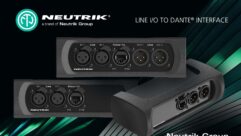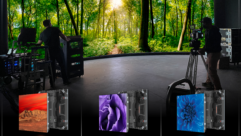Tic-Tac-Toe, Three Clubs in a Row
San Francisco-based integrator JK Sound took its expertise on the road to help a hometown club owner expand into the state’s capital. The results have been good for everyone.
One nightclub’s ceiling sports a sistine chapel–inspired painting of God giving Adam an electric guitar. Another features a 7,500-gallon aquarium where mermaids and mermen perform aquatic ballets. You might think you’re in Las Vegas, where “over-the-top” is taken for granted. But you’d be surprised to learn that you’re in Sacramento, Calif., the state capital known more for political mayhem than hard-core clubbing. Three new venues, opened in January and backed by a $5.7 million subsidy from the Sacramento City Council, now anchor the newly revitalized K Street Mall in the city’s downtown.
Each of the three venues, all owned by San Francisco nightclub operator George Karpaty, has a very different décor. Pizza Rock delivers a full-sized Peterbilt semi-truck half-way through a wall, which serves as the DJ platform. The Dive Bar’s dressing is more literal than its name suggests, with a massive aquarium where costumed divers swim among the fish and play off the crowd. A sophisticated 30-something crowd enjoys a more upscale experience in the disco-restaurant District 30, with its videowall technology. But what all of these venues share, in addition to their role in staging the comeback of Sacramento’s historically dodgy downtown, is a huge emphasis on audio performance.
“The biggest challenge here was doing all three venues at the same time,” recalls Brad Katz, lead systems integrator for JK Sound, which had previously worked with Karpaty on the Ruby Skye club in San Francisco. He says that the project’s complexity was compounded by a constantly evolving sound system designed to take into account a new speaker product from EAW, the QX Series. “It had all of the usual challenges of doing a high-profile systems installation, except times three,” he says.
Playing the Angles
District 30 was the first venue to be integrated. First, JK Sound sound designer and contractor Michael Lacina recommended that the team implement some acoustical treatment in the form of Tectum cloud panels suspended from the ceiling. Then the main sound-system components were installed. District 30’s dance floor is surrounded by four EAW QX596 high-output three-way loudspeakers. Katz describes the dance floor as a parallelogram, with two sides facing each other and two not, resulting in both acute and obtuse corner angles. Speaker placement, therefore, was critical in order to avoid reflections.
“The acoustical treatment helped, but it was mainly about angling the speakers correctly, about how far to go into the corners because the corner angles are different from each other,” Katz explains. The initial locations for the Hilti Unistrut grid hanging system were determined by sight, based on hours spent poring over the architectural plans, as well as projecting the height of the acoustical clouds in an effort to keep the speakers below them. But it was time well spent—the initial fly points proved to be mostly spot-on, and it only took a little extra finesse to get the speakers hung.
Tic-Tac-Toe, Three Clubs in a Row
San Francisco-based integrator JK Sound took its expertise on the road to help a hometown club owner expand into the state’s capital. The results have been good for everyone.
Another challenge during system setup was that this was the first installation of EAW’s new QX596 loudspeaker in a club environment. The design—a triaxial speaker in which three separate driver groups for highs, mids, and lows all emerge from the speaker as one point source on the same axis—proved to be a good one for the room. “Because the speaker design focuses the entire spectrum so well, we get a lot of clarity and power without having to overwhelm the room,” says Katz.
Lacina adds, “This system can pressurize the room without ever running near capacity. That means the components are never being stressed.”
In addition to the QX596s, District 30’s dance floor includes two EAW SB528zP large-format subwoofers, stacked vertically to focus the bass without overloading the room with low end, and an EAW UX8800 digital signal processor. Elsewhere, four JF29 compact full-range loudspeakers and an SB250z medium format subwoofer serve the bar area; four JFX88 compact full-range loudspeakers and an SB150z compact subwoofer are in the VIP area; two VR61 compact full-range loudspeakers cover the lobby area; and eight CIS400 ceiling loudspeakers are in the bathroom areas.
Taking a Dive
Speaker placement and acoustical panels are also key ingredients of the sound system in the Dive Bar. “It’s a pretty thin, narrow room and the key to making the sound work there was the downtilt of the speakers, along with the dampening of the room with the Tectum panels,” Katz says.
The Dive Bar also needed to be the most flexible of the three venues. For example, audio input can come from a giant fabricated iPod dock that allows patrons to pump their own music through a system set up on the dance floor. The dance floor is covered by four EAW JF29 speakers, which are hung using a single pole of all-thread rod terminating in a double bridle mount. In addition, there are two SB250z speakers and a UX8800 processor in the front lounge area; three JFX88 enclosures and an additional SB250z in the main bar and aquarium area; four JF50S compact full-range loudspeakers in the game room; and eight CIS400s in the bathroom areas.
“The JF29 speakers have good directivity, and once we found the right downtilt angles, we didn’t need a feedback suppressor, even for the dueling pianos on the dance floor,” Katz says.
In between the Dive Bar and District 30 is where partiers as well as families can get a bite and enjoy good music. Pizza Rock’s sound system includes eight JFX590s, two SB528zP subs, and a BSS Soundweb London processor in the main dining and bar area; two VR62 compact full-range loudspeakers in the club’s brick-oven-pizza entry area; two VR61s in the front patio area; and eight more CIS400’s in the bathroom areas.
Because the clubs are all located in a row on Sacramento’s K Street, the sound systems from all three venues are connected together so that music from any venue can be transmitted to any of the others. Signal routing has the S/PDIF output of the Pioneer DJ M800 mixer in District 30 going to a S/PDIF-to-AES converter and then straight to the UX8800 processor, keeping an all-digital front-end from the CD player to the main processor for the cleanest audio possible. The analog output is routed to BBS Soundweb units for distribution to the other venues when needed. The DJ mixer itself is always on and acts as the main mixer for the house audio.
Ultimately, an adroit combination of speaker choice, placement, and processing (including liberal use of the Gunness Focusing digital loudspeaker correction capability of the UX8800 processor to compensate for room anomalies) resulted in what Katz calls “a club sound system that sounds like studio monitors.”










